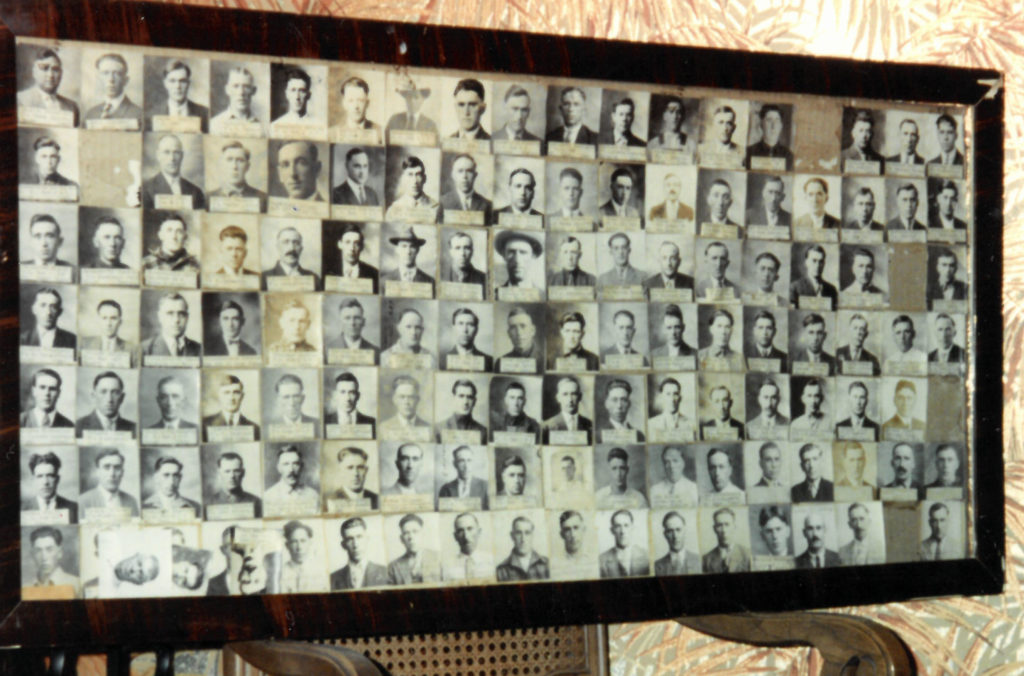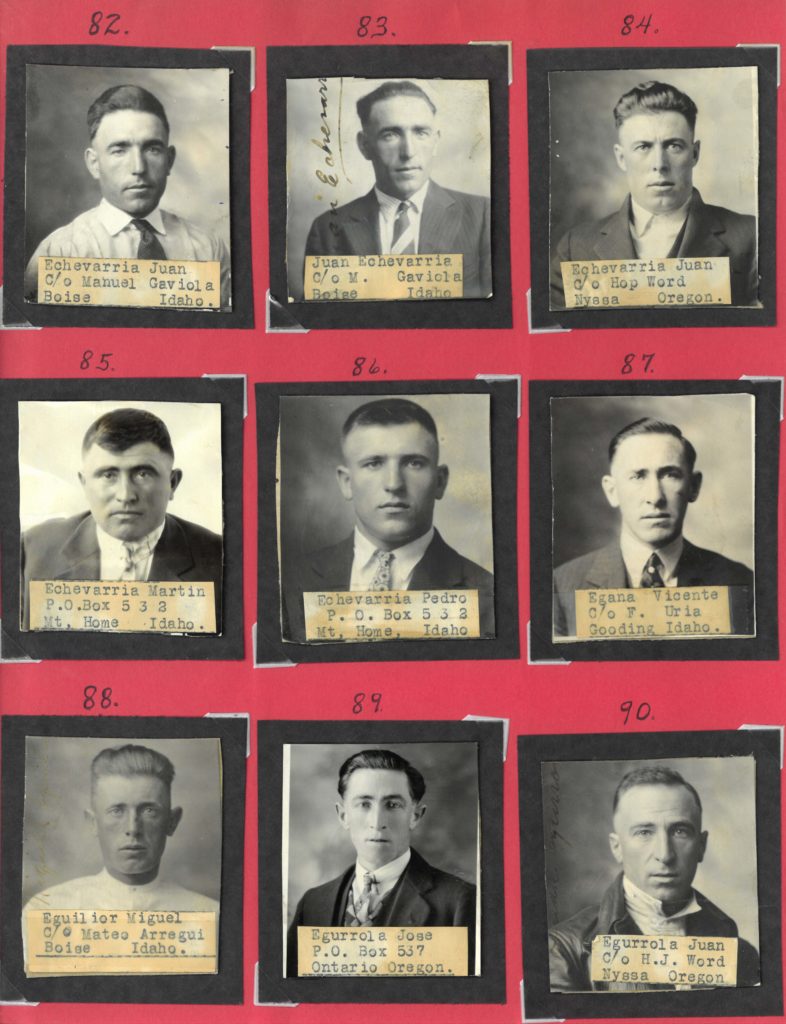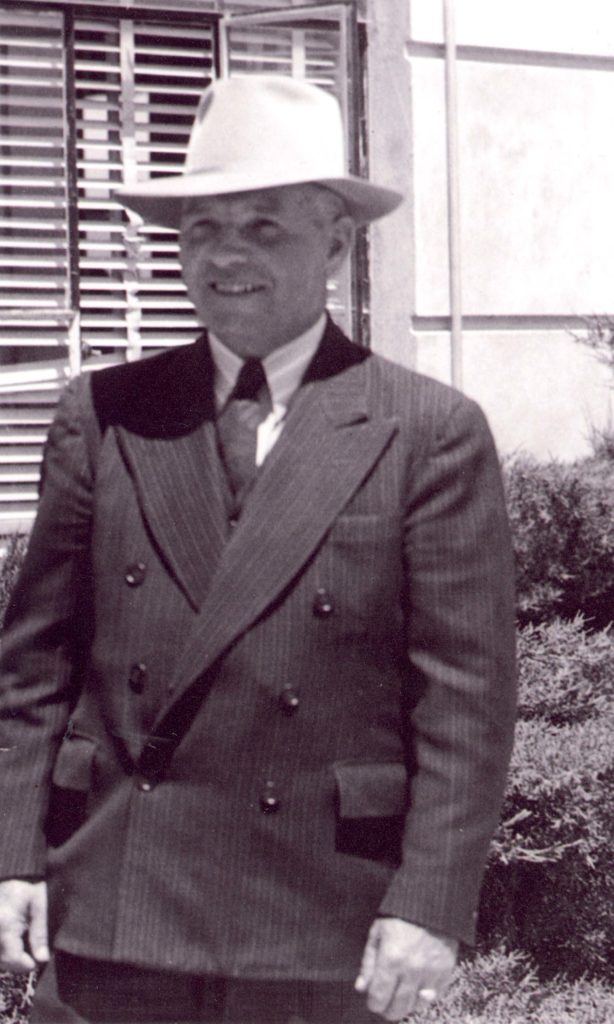
For many years, a collection of photographs featuring Basque immigrant men hung in the Basque Center card room in Boise, Idaho. The photos reflected a shared history among those who gathered regularly at the Basque Center – a story of immigration and new beginnings in the American West. Bonifacio Garmendia created this collection of photographs, each man – a Basque immigrant – that he helped to settle in Idaho, Oregon, Utah, Colorado, and even New York. He assisted with paperwork and language barriers. He framed these photos and had them hanging in his home office. Upon his passing, Boni’s family donated the framed photos to the Basque Center.

In 1991, Helen Berria saw the historical value in these photos that could deteriorate in their frames and created a scrapbook to better house the images. Over the years, many individuals have flipped through the pages to find their family members and share memories and stories of an era passed. The Basque Museum & Cultural Center has used these images in exhibitions and in 2019, the Basque Center donated the album to the Museum to care for and store for perpetuity. To keep the album’s rich history safe but accessible, the BMCC has created an online version of the scrapbook along with the history of the Bonifacio Garmendia family.
To see the full screen version of the book, click the expansion icon ![]() . To search within the text, click the expansion icon and then click the magnifying glass
. To search within the text, click the expansion icon and then click the magnifying glass ![]() in the upper right-hand corner of the book.
in the upper right-hand corner of the book.
If we had all paid closer attention, listened more carefully, and had more of a sense of family history, this would be a more complete story. As it is, this is a combination of the grandchildren’s collective memories of conversations, lectures, and isolated remarks that have “stuck”. I share it with much pride, a few tears, and begin with Aichicha (Aitxitxa – Grandfather).

Boni and Juli (Echevarria) Garmendia (taken from
La Historia de los Vascongados en el Oeste)
Bonifacio (Boni) Garmendia was born June 5, 1889, in Ondarroa, Vizcaya, Spain. He had a brother, José and two sisters, Amadea and Joaquina. He attended school for a few years where he learned to read, write, and do basic math. His skills in the latter were improved as he worked in his grandfather’s flour mill (and possibly a bakery) and learned to keep accounts. His moving to the United States came as a result of his family’s poverty. He dared to leave “the old country” and make a better life for himself in the U.S. where, it was said, gold and the opportunity for wealth were just waiting for anyone with ambition. So, in 1907 (age 18), with the aid of a cousin who worked in the Spanish consulate in New York City, Boni and his brother José sailed to the U.S. From New York, they continued west by train as far as Ogden, Utah, where they obtained employment herding sheep. This was a miserable period for them: herding sheep afforded neither the opportunity for advancement nor the riches that they had envisioned, and the English language eluded them. During the winter “in-town” season, Boni took English lessons that were offered in Ogden but he found the new language to be both difficult and confusing, and it was an embarrassment to him not to be a faster learner. Discouraged, but seeking a solution, he and José travelled to South America (probably to Argentina) where language would not be a barrier, and where they could still seek their fortunes. None of us know why things didn’t work out there, but we do know that José returned to Spain and Boni to Ogden – from where he sent to Ondarroa for his bride-to-be.
Juliana Echevarria was born in Ondarroa, June 19, 1896. She had sisters Veronica, Josefina, and Regina, and brothers Evaristo, Doroteo and Anacleto. Her family was also poor, probably even more impoverished than the Garmendias. So, at age 19, when Boni offered the opportunity to come to America, she got herself a new wardrobe (that her mother said made her look “like a princess”) and she travelled to Ogden. There she worked in a hotel/boarding house for “Asun” who became her very close friend and advisor until the day when Boni announced to her that “if you want to get married with me… come on now… I’ve made the arrangements.” So, on November 30, 1914, before the Judge of the District Court, 2nd Judicial District, Ogden, State of Utah, Bonifacio Garmendia (age 25) and Juliana Echevarria (age 18) were married. They remained in Ogden for some time where Boni worked both with sheep and also in a pool hall (all the while putting away in savings a regular amount from each paycheck). In 1916, a son Joe was born, and there’s a beautiful picture of the baby Joe, Boni, Juli, and uncle José who perhaps had returned to visit.
At about this time, Juli and Boni borrowed $500 from a Mr. Bengochea to finance Juli’s sister Regina’s travel from Ondarroa to Ogden. The story remembered is that when Juan Bastida proposed to Tia (Aunt) Regina, she told him that first he should know she would need a lot of money to buy a proper trousseau – which he willingly supplied – and with which she promptly repaid the loan for her passage.
By 1917, Boni, Juli, and Joe had moved to Boise, where Carmen was born in 1917, at their Grove Street residence, an area of town where numerous Basques were settling. Boni continued herding sheep, studying English, and obtained US citizenship, something he valued deeply for the rest of his life. During this time too, he saved enough money to buy his own flock of sheep, perhaps in partnership with John Archabal. Around 1920, Boni bought a house at 1009 Eastman in Boise, and moved his family from the Basque enclave so that they could be more fully immersed in the American ways of life and language. This move was particularly difficult for Juli who greatly missed the camaraderie of her friends back in the old neighborhood. She never learned to drive a car so she was somewhat isolated in the family’s new area of town.
A second daughter, Regina (Heen) was born in 1923, at the same time that her older brother Joe started elementary school at Longfellow School. After Heen’s birth, Juli suffered for a long time from a gastric illness that her doctor was unable to cure. A Scottish neighbor, Mrs Allen, took care of Heen for a long time until Juli finally regained her health, thanks to the medical knowledge of a Chinese herbalist. Heen used to tell us that she learned to speak Scottish before she moved back with her family and then learned to speak Basque and English.
By the mid-1920’s, Boni had gotten out of the sheep business and owned a pool hall (The Merino on 7th and Main Street) in Boise, where Joe also worked after school. In 1924, Carmen started at Longfellow School. It is clear that she was a good learner and that Boni considered her to be a sharp child because, when she was 10 years old, he sent her (with $1200 in cash) to purchase a bright yellow house that he had spotted at 1719 N. 9th Street. She must have negotiated well, because the deal was made and the five Garmendias moved in.
While Joe, Carmen, and Heen were growing up, there were summer weeks spent visiting in Ontario, Oregon, with the Mendiola family: Tio (Uncle) Vicente, Tia Carmen – an aunt of Boni’s – Julian and Little Carmen. Likewise, there was frequent visiting with the Bastidas: Tio Juan, Tia Regina, Alice, Flora, and Blanche, and Juli returned to Ogden whenever possible to enjoy her special friends there. Boni even made a return visit to Spain, accompanying his friend John Archabal and his family.
By 1930, Joe was a student at Boise High and Heen had started at Longfellow School. Those years in the “house that Carm bought” were momentous ones. For heroism, Joe is remembered for jumping into the canal and swimming through a culvert across the street to rescue a small child who had fallen in. (And for stupidity for getting deathly ill after eating a gunny sackful of peanuts that he and his friend John Asumendi had found and hidden away under the house). For Carmen, these were her adolescent years, and she and her friends tried to test out their independence – with Heen “taggin’ along behind them.” Heen remembers the day Boni sat her down on back steps and solemnly said, “Txiki (Little One), the banks have closed.” She really didn’t know just what that meant, but from the tone of his voice and the look on his face, she knew that she’d just been given some very bad news.
From comments passed on later by other Basque people who lived in Boise at that time, it becomes clear that Boni and Juli became “the rock” of the Basque community during the Depression. Boni helped all who needed his assistance with interpreting, paperwork and advice, and Juli shared her hearty spirit with her friends who were down on their luck.
In matters of education, Boni had strong opinions, and his most feverent one was that the schools were not teaching his children enough, so he took matters into his own hands and ordered lessons from the La Salle Business School in Chicago. When instructional packets from them arrived from time to time, Boni summoned Joe and Carmen to the dining room table and proceeded to instruct them in the current material which usually resulted in great frustration, screaming, and carrying on by teacher and students alike, except Heen who sat by taking all of this in.

Bonifacio Garmendia
Around this time, Boni sold the pool hall and became a wool buyer for Henry Clay and Company, of Boston, Massachusetts. Returning from his necessary trips to the sheep camps, he frequently brought home sheep collies, which the kids loved, and Juli hated because they tore up her lovely flower beds. Equally upsetting to her was Boni’s tendency to “trim” her precious fruit trees until only the stumps remained!
In 1934, Joe graduated from Boise High School (perhaps in spite of the LaSalle courses) and went to work for Hitchcock Service Station and later for Mountain States Wholesale. He married Helen Skelton in 1938, and in 1941, started work on a construction crew for Idaho Power Company. When that work was halted because of World War II and the scarcity of materials, he and Helen moved to Seattle, Washington, where he worked for Boeing Aircraft until August of 1945, when they returned to Boise and to Idaho Power. Their daughter Louise was born in 1942, and their younger daughter Julie in 1947.
After graduating from Boise High in 1936, Carmen attended Boise Business College then worked for KIDO radio for five years. She and Joe Cook were married in 1940 and moved to Seattle to work for Boeing Aircraft in 1942. After Joe Cook’s Army Air Force service and the end to the war, Carmen and Joe returned to Boise, and then on to Fairfield (Idaho) where they operated Cook’s Grocery until 1970. Their son Mike was born in 1947, and daughter Janet was born in 1950.
During that time, Heen was going through high school (graduating in the class of 1941), Boise Junior College (AA, 1943), and the University of Oregon (BA, 1945). She returned to Boise and worked as an assistant personnel manager in the CC Anderson chain, then accepted a position as assistant buyer and then buyer for Lipman Wolfe in Portland, Oregon, where she worked for 4 1/2 years. She married Dick Dukas in 1950 in Oakland, California, and in 1954, they had their son Mark.
Boni and Juli moved out to “the bench” in Boise in 1950, to a house on Crescent Rim Drive. Juli enjoyed the spacious yard for her flowers and fruit trees, and Boni had room for his personal office. After Boni’s death in 1968, Juli sold the house and moved into a lovely apartment near many of her friends in downtown Boise. She died in 1973.
Now that I’ve put down “the facts” as they’ve been passed on to me, I’ll add just a bit more “color” to the Boni and Juli descriptions… they become Aichicha and Amuma (Grandfather and Grandmother).
Amuma loved music, crocheting, movie magazines (could she read them?), and visiting with her many friends. She was an excellent cook and her meals were bountiful offerings with hearty use of olive or Mazola oil and garlic. Her exclamations of “Hay-soos” and “Ay-ay-ay” peppered her conversations, and her voice rang out with joy as she sang her favorite Basque, Spanish, and Italian songs. She was a master of honest affection, though a real stoic who kept her own counsel when her own hardships hit. Within the allowance that Aichicha doled out to her, she had her special habits such as buying fresh fish every Friday at the Main and Fifth Street market and baking a five-dollar gold piece into her children’s birthday cakes as a special treat. And, (how can we forget?), her money was always in a little black latched coin purse that fit in her pocket, with the paper money all scrunched in on top of the coins. She attended citizenship classes and loved the United States as her country and always appreciated the pleasure of living here. On returning from a visit to Spain, she told me, “Honey, when I saw that lady standing in the harbor, I knew that I was HOME.”
Aichicha too, loved the United States and was honored to serve his new country as a

Idaho’s “Home Guard” during World War II, Boni Garmendia is in the front row, farthest left (2003.72.23).
uniformed neighborhood warden during World War II, proudly wearing his official jacket and helmet to protect his block. He was a questioning man, be it politics, mechanics, or business, and he truly built that better life that he had come searching for. He mastered English to the point of being the “Boise expert” when a Basque interpreter was needed and likewise, served as sponsor for many other Basques coming into the U.S. He expected them to work hard and to follow the standards he set when he sponsored them. In record-keeping he was meticulous – with names, dates, addresses, wool classifications, or finances – he kept track of them all. Like Amuma, he loved his music, his guitar, his family and friends, and especially, his coffee with vanilla ice cream!
Boni and Juli Garmendia epitomize the aspirations and hard work accomplishments of immigrants who come to this country.
Eskerrik asko, Amuma and Aichicha, for leading the way for the rest of us.